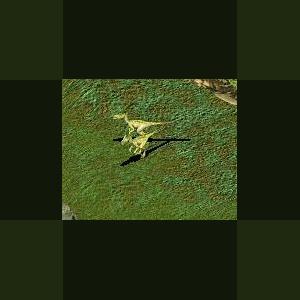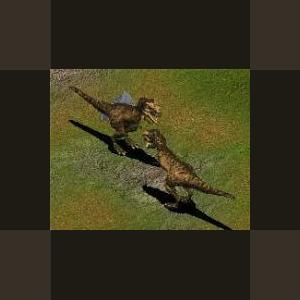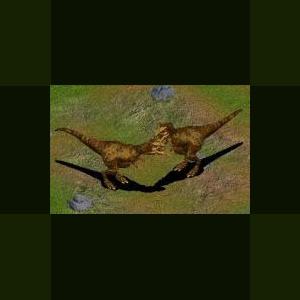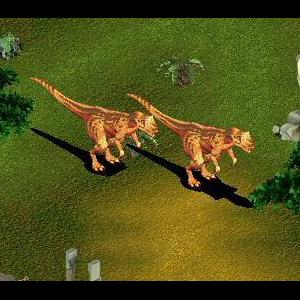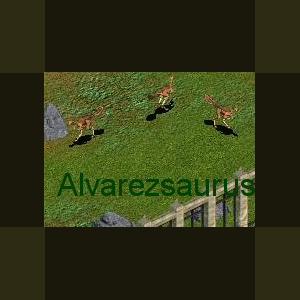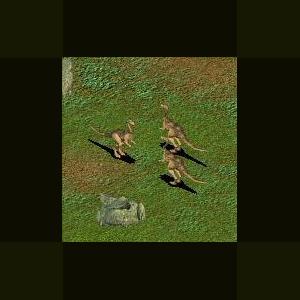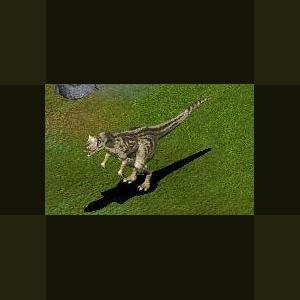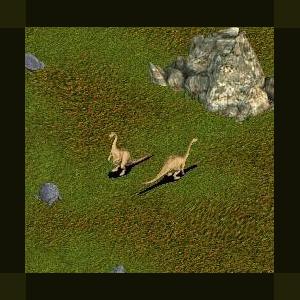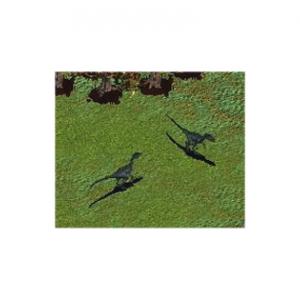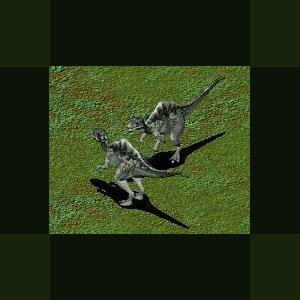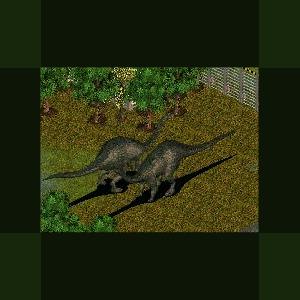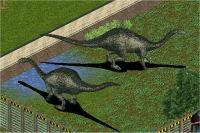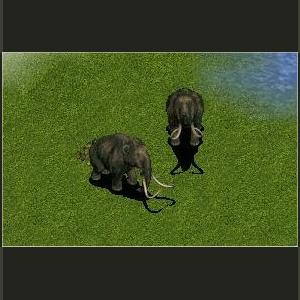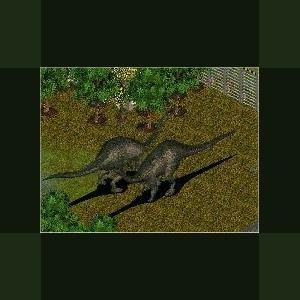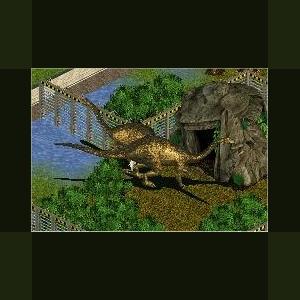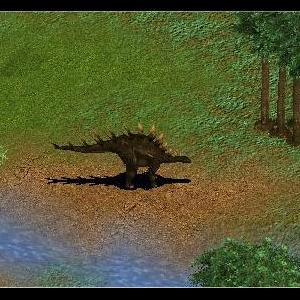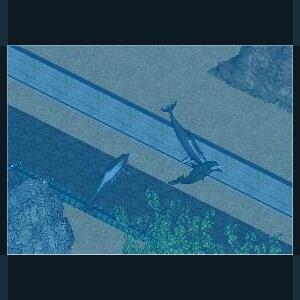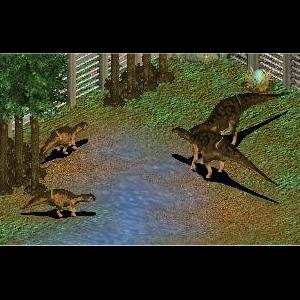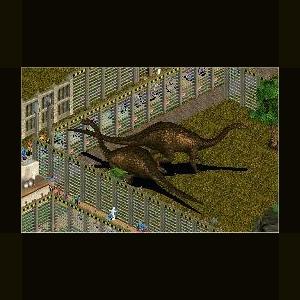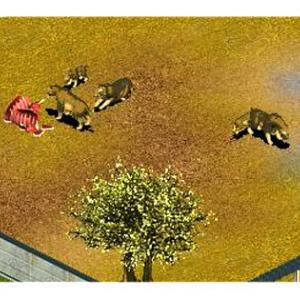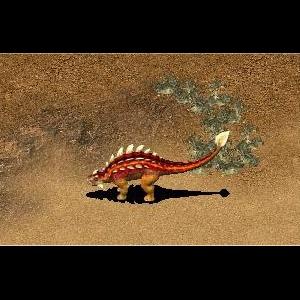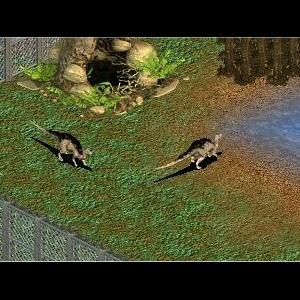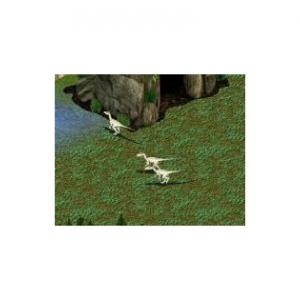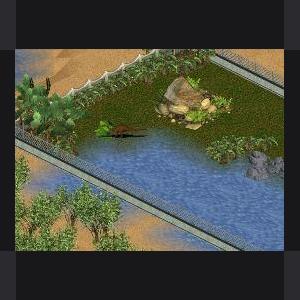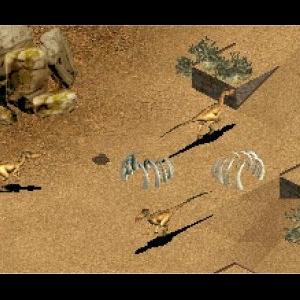Dinosaurs
Creatures from another age
241 files
-
Achillobator by Moondawg
By Guest
Achillobator (meaning "Achilles' warrior/hero") is a genus of dromaeosaurid theropod dinosaur from the late Cretaceous Period of what is now Mongolia.
Fossil bones of Achillobator were found mostly disarticulated, but associated, including a fragment of the upper jaw with teeth, as well as vertebrae from all sections of the spinal column, ribs, and bones from the shoulder, pelvis, forelimbs and hindlimbs. These remains were found in the Bayan Shireh Formation of Dornogovi Province, Mongolia, which dates to the Late Cretaceous epoch. The exact age is uncertain, with two competing hypotheses; based on comparisons with other formations, the Bayan Shireh fauna seems to correspond best with the Turonian through early Campanian stages of the Late Cretaceous, about 93 to 80 million years ago. However, examination of the magnetostratigraphy of the formation seems to confirm that the entire Bayan Shireh lies within the Cretaceous Long Normal, which lasted only until the end of the Santonian stage, giving a possible Cenomanian through Santonian age, or between 98 and 83 million years ago. Other dinosaurs found in the Bayan Shireh include Alectrosaurus, Segnosaurus, Talarurus, and Bactrosaurus
349 downloads
Updated
-
Alioramus by Moondawg
By Guest
Alioramus ( meaning 'different branch') is a genus of tyrannosaurid theropod dinosaur from the Late Cretaceous Period of Asia.
The type and only species, A. remotus, is known from a partial skull and three metatarsals recovered from Mongolian sediments which were
deposited in a humid floodplain between 70 to 65 million years ago. These remains were
named and described by Russian paleontologist Sergei Kurzanov in 1976. Its relationships
to other tyrannosaurid genera are unknown, but some experts believe Alioramus is closely
related to the contemporaneous Tarbosaurus, or is a juvenile of that genus.
While very little skeletal material is known, Alioramus was probably bipedal like most
theropods, and its sharp teeth indicate that it was a carnivore. It was smaller than
tyrannosaurids like Tarbosaurus and Tyrannosaurus, but its adult size is difficult to
estimate since it is known mainly from a skull, which may belong to a juvenile. Alioramus
is characterized by the row of five bony crests along the top of its snout, and also has
more teeth than any other tyrannosaurid. Its skull is lower than those of other
tyrannosaurids, but this might be a juvenile feature.
Alioramus was estimated at between 5 and 6 meters (16.5 to 20 ft) in length when
originally described by Sergei Kurzanov in 1976. Kurzanov, however, did not correct for
lengthening of the skull by deformation during fossilization, which may indicate a shorter
overall body length for this individual. If this specimen is a juvenile, then adult
Alioramus would have reached greater lengths, but no confirmed adult specimens are known.
Inspired by the Zoo Tek Brains Trust
285 downloads
Updated
-
Albertosaurus by Moondawg
By Guest
Albertosaurus (pronounced ; meaning 'Alberta lizard') is a genus of tyrannosaurid theropod dinosaur that lived in western North America during the Late Cretaceous Period,
As a tyrannosaurid, Albertosaurus was a bipedal predator with tiny, two-fingered hands and a massive head with dozens of large, sharp teeth. It may have been at the top of the food chain in its local ecosystem. Although relatively large for a theropod, Albertosaurus was much smaller than its more famous relativeTyrannosaurus, probably weighing less than 2 metric tons.
Fossils of more than thirty individuals have been recovered, providing scientists with a more detailed knowledge of Albertosaurus anatomy than is available for most other tyrannosaurids. The discovery of 22 individuals at one site provides evidence of pack behavior and allows studies of ontogeny and population biology which are impossible with
lesser-known dinosaurs
433 downloads
Updated
-
Afrovenator by Moondawg
By Guest
Afrovenator ("African hunter") is a genus of megalosaurid theropod dinosaur from the Early Cretaceous Period of northern Africa.
It was a bipedal predator, with a mouthful of sharp teeth and three claws on each hand. Judging from the one skeleton known, this dinosaur was approximately 30 feet (9 meters) long from snout to tail tip.
The generic name comes from the Latin prefix afro- ("from Africa") venator ("hunter"). There is one named species, A. abakensis. The name refers to its predatory nature, and its location in Africa, specifically from In Abaka, the Tuareg name for the region of Niger where the fossils were found. The original description of both genus and species is found in a 1994 paper which appeared in the prestigious journal Science. The primary author was well-known American paleontologist Paul Sereno, with Jeffrey Wilson, Hans Larsson, Didier Dutheil, and Hans-Dieter Sues as coauthors.
The remains of Afrovenator were discovered in the Tiourarén Formation of the department of Agadez in Niger. The Tiourarén most likely represents the Hauterivian to Barremian stages of the Early Cretaceous Period, or approximately 136 to 125 million years ago (Sereno et al. 1994). The sauropod Jobaria, whose remains were first mentioned in the same paper which named Afrovenator, is also known from this formation.
Afrovenator is known from a single nearly complete skeleton, featuring most of the skull (minus the mandible, or lower jaw), parts of the spinal column, hands, and forelimbs, a nearly complete pelvis, and complete hind limbs. This skeleton is housed at the University of Chicago.
Most analyses place Afrovenator within Megalosauridae, which was formerly a "wastebasket family" which contained many large and hard-to-classify theropods, but has since been redefined in a meaningful way, as a sister taxon to the family Spinosauridae within the Spinosauroidea.
A 2002 analysis, focused mainly on the noasaurids, found Afrovenator to be a basal megalosaurid. However, it did not include Dubreuillosaurus (formerly Poekilopleuron valesdunesis), which could affect the results in that region of the cladogram (Carrano et al. 2002).
Other recent, more complete, cladistic analyses show Afrovenator in a subfamily of Megalosauridae with Eustreptospondylus and Dubreuillosaurus. This subfamily is either called Megalosaurinae (Allain 2002) or Eustreptospondylinae (Holtz et al. 2004). The latter study also includes Piatnitzkysaurus in this subfamily.
A few alternative hypotheses have been presented for Afrovenator's relationships.
382 downloads
Updated
-
Alvarezsaurus by Moondawg
By Guest
The Alvarezsauridae are an enigmatic family of small, long-legged running dinosaurs. Although originally thought to represent the earliest known flightless birds, a consensus of recent work suggests that they are primitive members of the Maniraptoriformes. Other work found them to be the sister group to the Ornithomimosauria. Alvarezsaurs are highly specialized. They bear tiny but stoutly proportioned forelimbs with compact birdlike hands and their skeleton suggests they had massive breast and arm muscles, possibly adapted for digging or tearing. They have tubular snouts, elongate jaws, and minute teeth. They may have been adapted to prey on colonial insects such as termites. Alvarezsaurids range from 0.5.2 m (20-80 inches) in length, although some possible members may have been substantially larger, including the European Heptasteornis (also called Elopteryx) that may have reached 2.5 m (8 ft).
At least one species of Alvarezsaurid, Shuvuuia deserti, has down-like, feathery, integumental structures that are preserved in the fossil. Schweitzer et al. (1999) subjected these filaments to microscopic, morphological, mass spectrometric, and immunohistochemical studies and found that they consisted of beta Keratin, which is the primary protein in feathers.
Alvarezsaurus, and thus Alvarezsaurinae, Alvaresauridae, and Alvarezsauria are named for the historian Don Gregorio Alvarez, not the more familiar physicist Luis Alvarez, who proposed that the Cretaceous-Tertiary extinction event was caused by an impact event.
The type species is A. calvoi. It was bipedal, had a long tail and its leg structure suggests that it was a fast runner. It may have been insectivorous and was basal to better-known members of its family, such as Mononykus and Shuvuuia. It has been alternately classified with both non-avian theropod dinosaurs and early birds
260 downloads
Updated
-
Agilisaurus by Moondawg
By Guest
Acrocanthosaurus (pronounced ak-ro-KAN-tho-SAWR-us; meaning 'high-spined lizard') is a genus of allosauroid theropod dinosaur that existed in what is now North America during the mid-Cretaceous Period
The skull of Acrocanthosaurus, like most other allosauroids, was long, low and narrow. The weight-reducing opening in front of the eye socket (antorbital fenestra) was quite large, more than a quarter of the length of the skull and two-thirds of its height. The outside surface of the maxilla (upper jaw bone) and the upper surface of the nasal bone on the roof of the snout were not nearly as rough-textured as those of Giganotosaurus or Carcharodontosaurus. Long, low ridges arose from the nasal bones, running along each side of the snout from the nostril back to the eye, where they continued onto the lacrimal bones. This is a characteristic feature of all allosauroids. Unlike Allosaurus, there was no prominent crest on the lacrimal bone in front of the eye. The lacrimal and postorbital bones met to form a thick brow over the eye, as seen in carcharodontosaurids and the unrelated abelisaurids. Nineteen curved, serrated teeth lined each side of the upper jaw, but a tooth count for the lower jaw has not been published. Acrocanthosaurus teeth were wider than those of Carcharodontosaurus and did not have the wrinkled texture that characterized the carcharodontosaurids. The dentary (tooth-bearing lower jaw bone) was squared off at the front edge, as in Giganotosaurus, and shallow, while the rest of the jaw behind it became very deep. Acrocanthosaurus and Giganotosaurus shared a thick horizontal ridge on the outside surface of the surangular bone of the lower jaw, underneath the articulation with the skull.
235 downloads
Updated
-
Acrocanthosaurus by Moondawg
By Guest
Acrocanthosaurus (pronounced ak-ro-KAN-tho-SAWR-us; meaning 'high-spined lizard') is a genus of allosauroid theropod dinosaur that existed in what is now North America during the mid-Cretaceous Period
The skull of Acrocanthosaurus, like most other allosauroids, was long, low and narrow. The weight-reducing opening in front of the eye socket (antorbital fenestra) was quite large, more than a quarter of the length of the skull and two-thirds of its height. The outside surface of the maxilla (upper jaw bone) and the upper surface of the nasal bone on the roof of the snout were not nearly as rough-textured as those of Giganotosaurus or Carcharodontosaurus. Long, low ridges arose from the nasal bones, running along each side of the snout from the nostril back to the eye, where they continued onto the lacrimal bones. This is a characteristic feature of all allosauroids. Unlike Allosaurus, there was no prominent crest on the lacrimal bone in front of the eye. The lacrimal and postorbital bones met to form a thick brow over the eye, as seen in carcharodontosaurids and the unrelated abelisaurids. Nineteen curved, serrated teeth lined each side of the upper jaw, but a tooth count for the lower jaw has not been published. Acrocanthosaurus teeth were wider than those of Carcharodontosaurus and did not have the wrinkled texture that characterized the carcharodontosaurids. The dentary (tooth-bearing lower jaw bone) was squared off at the front edge, as in Giganotosaurus, and shallow, while the rest of the jaw behind it became very deep. Acrocanthosaurus and Giganotosaurus shared a thick horizontal ridge on the outside surface of the surangular bone of the lower jaw, underneath the articulation with the skull.
484 downloads
Updated
-
Anchisaurus by Moondawg
By Guest
Anchisaurus (from Greek anchi-; "near, close" + Greek sauros; "lizard", probably referring to Marsh's interpretation of it as intermediate between more primitive dinosaurs [at the time Palaeosaurus was an example of what was thought to be a primitive dinosaur] and more derived dinosaurs) is a genus of prosauropod dinosaur. The name Anchisaurus was coined as a replacement name for Amphisaurus, which was a replacement name for Hitchcock's Megadactylus, both of which had already been used for other animals.
The first discovery of Anchisaurus remains was made before anything was known about dinosaurs and it was probably the first dinosaur discovery in North America. When, in 1818, some large bones were discovered in Connecticut, USA, it was assumed that they were of human origin.Gradually, as a result of further finds in Massachusetts, the number of these bones began to accumulate and, by 1855, they were at least recognized as reptilian.
Hitchcock collected these bones under the name Megadactylus in 1865. Unfortunately, the name was in use, and the famous paleontologist Othniel Charles Marsh renamed it Anchisaurus in 1885. Remains thought to belong to this genus were found in South Africa and China, adding to the theory that these land masses were at the time joined in one super-continent, Pangaea, but these assignments have been contentious (Gyposaurus). A recovery from Nova Scotia may also be an Anchisaurus but this is unconfirmed.
Today, parts of Anchisaurus' skeleton are still missing. Reconstructions usually assume that the tail and neck were prosauropod-like. Recent analyses, however, put Anchisaurus firmly at the base of the Sauropoda, making it the most basal known sauropod.
Anchisaurus was a rather small dinosaur, with a length of just over 2 metres (6.6 ft), which helps explain why it was once mistaken for human bones. It probably weighed around 27 kilograms (60 lb). However, Marsh's species A. major (also known as Ammosaurus) was larger, from 2.5 to 4 metres (8 ft 2 in to 13 ft 1 in) and some estimates give it a weight of up to 70 pounds (32 kg). All species of Anchisaurus lived during the Early Jurassic Period; more specifically, the Pliensbachian to Toarcian ages, 200 to 188 million years ago.
Digesting plant matter is a much more intensive biochemical process than digesting meat. This herbivore swallowed gastroliths (gizzard stones) to help break down the food in its stomach. Herbivorous dinosaurs needed a huge gut. Since this had to be positioned in front of the pelvis, balancing on two legs became increasingly difficult, as dinosaurs became larger and they gradually evolved into the quadrupedal position that characterizes the later sauropods such as Diplodocus. Prosauropods represented a middle phase between the earliest bipedal herbivores and the later giant sauropods. Although it was not itself a prosauropod, Anchisaurus was mostly typical of this group, which flourished briefly during the late Triassic and early Jurassic. Anchisaurus teeth, used to rip food, were shaped like spoons. It had fewer and more widely spaced teeth than true prosauropods, and as Peter Galton and Michael Cluver observed, narrower feet. Anchisaurus would have spent most of its time on four legs but could have reared up on its hind legs to reach higher plants.
On the other hand, some paleontologists believe Anchisaurus may also have eaten meat, as it was in the transition between these two ultimately distinct groups. The teeth were blunt but with file-like edges, suggesting mostly plant matter was eaten and the jaw hinge was arranged in a way not entirely suited for tearing meat. Nevertheless, there is still some debate. The thumb had a large claw and the large eyes were not entirely on the side (as would be expected in an animal of a natural prey species).
As a quadrupedal/bipedal crossover, Anchisaurus had to have multi-purpose front legs. As 'hands', they could be turned inwards and be used for grasping. It had a simple reversible first 'finger', similar to a 'thumb'. As feet, the five toes could be placed flat against the floor and were strong at the ankle. This unspecialized design is typical of the early dinosaurs.
Due to its primitive appearance, Anchisaurus was previously classified as a prosauropod, a member of a group of animals related to or ancestral to the sauropods. Recent investigations show that Prosauropoda forms a monophyletic sister-group to Sauropoda and that Anchisaurus is instead a very basal sauropod.
Marsh was originally happy with Hitchcock's name Megadactylus but this name was already taken. Therefore, he renamed it Amphisaurus in 1882. However, this name was also already in use and therefore, it became Anchisaurus in 1885.
The type species is Hitchcock's A. polyzelus. Marsh's A. major ("greater near lizard") is still often considered a valid species (as Ammosaurus) but his A. colurus (1891), once known as Yaleosaurus (von Huene, 1932), is now generally accepted as a female A. polyzelus, and his A. solus of 1892 is now reclassified as Ammosaurus major. However, Ammosaurus major itself may well be a synonym of A. polyzelus.
Broom named Gyposaurus capensis in 1911, from the bones discovered in South Africa but Peter Galton officially renamed it A. capensis in 1976. This species has since been reclassified again and is probably a juvenile of Massospondylus carinatus. G. sinensis was also referred here, but appears to be a distinct animal. Other specimens are still awaiting reclassification. This confusion is typical of the first dinosaurs to be discovered, when classification was not considered as important and precise a process as today.
333 downloads
Updated
-
Ebony Velociraptor by Ghirin
By Guest
Ebony Velociraptor
Author: Ghirin
http://www.zoo-tek.com/forums/index.php?download=109
The ebony velociraptor is a melanistic variant of the velociraptor. In melanism, the high production of melanin leads to dark brown or black fur and/or skin. Melanistic variants are found in many different species ranging from fish to mammals and in some cases this color variant does not pose a major handicap to the individual (unlike albinism and leucism).
Melanistic animals tend to have higher survival rates in areas of dense foliage, where the darker pigment might provide better camouflage. This appears to be the case in felines such as black leopards and jaguars. In other instances, such as animals living in open country with little plant cover would be at a disadvantage because they would be more conspicuous to prey or predators.
Like modern animals, melanistic individuals occurred in dinosaur populations. Predators that lived in forested areas probably had
References:
Designer Reptiles and Amphibians. R.D. Bartlett and Patricia Bartlett, 2001.
Reptile and Amphibian Variants: Colors, Patterns, and Scales. H. Bernard Bechtel, 1995.
The Corn Snake Manual. Bill Love and Kathy Love, 2000.
Walker's Mammals of World. Nowak, 1999.
Created by Ghirin
202 downloads
Updated
-
Irritator by Moondawg
By Guest
Irritator is a genus of spinosaurid dinosaur that lived in the early Cretaceous Period (Albian stage), around 110 million years ago.
Current estimations indicate a length of 8 meters (26 feet) and a height of 3 meters (9 feet). It was found in Brazil. Irritator was a theropod with an unusually shaped crest at the rear of its head, and probably ate fish.
So far the only fossil that has been found was an 80 centimeter long fossil skull in the Romualdo Member, a layer member of the Brazilian Santana formation. This skull strongly resembles the skulls of Suchomimus and Spinosaurus. The genus is often regarded today as identical (synonymous) with Angaturama, which lived in the same time and the same place as Irritator.
Irritator was first scientifically described in 1996 by paleontologists Martill, Cruikshank, Frey, Small and Clarke. Its only known fossil, an 80cm skull discovered in eastern Brazil, was badly obscured by plaster which was added by the commercial fossil-collecting amateurs who discovered it, and illegally sold it, since the trade of fossils is prohibited by law in Brazil, in hopes of making the fossil look more complete and valuable. It required a great deal of work to reconstruct the original features — hence the name.
It is probably synonymous with Angaturama limai, another spinosaurid from the same time and place, whose remains curiously seem to complete Irritator's skull, meaning that they could belong to the same specimen.
Material of I. challengeri, not counting that of A. limai, hails from the Romualdo Member of the Santana Formation in Brazil. The holotype is SMNS 58022, from the Stuttgart State Museum of the Natural Sciences, and it consists of an incomplete skull, lacking the anterior (front) portion.
The skull was recovered nearly complete and is considered the most complete head find of a Spinosaurid. It is characterized particularly by its unusual length and curved lip region, which is strongly compressed laterally. The overall length of the complete head is estimated at approximately 84 centimeters. It possesses a clear Sagittal crest; such a comb is found also with some other dinosaurs. The teeth exhibit a single embedding of the strongly extended and straight teeth with conical tooth crowns, which indicates a continual tooth change, as new teeth were pushed up between the old ones. The teeth exhibit lengths from 6 to approximately 40 millimeters.
In the year 2004 parts of a spinal column were discovered in the Santana Formation. These have been assigned, due to their structure, to the Spinosauridae. With very high probability these fossils belong to Irritator, since this is the so far the only so far well-known Spinosaurid of the formation.
Sorry I couldn't make the sail smaller so i left it as is :D
305 downloads
0 comments
Updated
-
Titanosaurus by Ghirin
By Guest
Titanosaurus (“Titanic Lizard”) was the first found of a distinct group of sauropods, the Titanosauria. This group of sauropods lasted from the late Jurassic to the late Cretaceous periods and seems to be indigenous to the southern hemisphere.
Titanosaurus looked similar to the Diplodocidae, having both a long neck and a whip-like tail. However, the skin on its back was studded with small bony plates called osteoderms.
References:
http://dinosauricon.com/genera/titanosaurus.html
Encyclopedia of Dinosaurs and Other Prehistoric Creatures. Malam and Parker, 2002
Dinosaurs. Parker, 2003
Created by Ghirin, 2004
299 downloads
0 comments
Updated
-
Cetiosaurus by Ghirin
By Guest
This therapod had a pair of bony ridges above its eyes and a horn on its snout. These were probably used by males when fighting for a mate.
Ceratosaurus (cera-TO-saur-US ) meaning 'horned lizard', in reference to the horn on its nose (Greek keras/keratos meaning 'horn' and sauros meaning 'lizard'), was a large predatory dinosaur from the Late Jurassic Period, found in the Morrison Formation of North America, in Tanzania and Portugal. It was characterized by large jaws with blade-like teeth, a large, blade-like horn on the snout and a pair hornlets over the eyes. The forelimbs were powerfully built but very short. The bones of the sacrum were fused (synsacrum) and the pelvic bones were fused together and to this structure (Sereno 1997) (i.e. similar to modern birds). A row of small osteoderms was present down the middle of the back.
186 downloads
0 comments
Updated
-
Steppe Mammoth by Ghirin
By Guest
Steppe Mammoth by Ghirin
The steppe mammoth (Mammuthus trogontherii) lived on the steppes that covered large portions of Eurasia.
This grassland was south of the ice sheets, but was still colder than the steppes of today.
The steppe mammoth may be descended from the ancestral mammoth, Mammathus mridionalis. It gave rise to the woolly mammoth of the late Pleistocene.
*Inspired by the Zoo tycoons brains trust at the Zoo Tek Evolved Forums.*
443 downloads
0 comments
Updated
-
Diplodocus by Ghirin
By Guest
Diplodocus ("Double Beam") was one of the sauropods found during the North American "Bone Rush" of the late 1800's. At that time, Diplodocus was the longest known dinosaur, though more recently discovered dinosaurs such as Supersaurus are longer. Even with its great length, Diplodocus was relatively light-weight (compared to Barosaurus and Apatosaurus).
Diplodocus' long, sloping skull became the type for a group of dinosaurs with similar skulls (the Diplodocidae). Other important features of Diplodocus include a long tail with a whip-like ending (possibly an anti-predator defense), a long neck, and skid-like projections on the vertebra of the middle tail region.
References:
http://dinosauricon....diplodocus.html
Encyclopedia of Dinosaurs and Other Prehistoric Creatures. Malam and Parker, 2002
Dinosaurs. Parker, 2003
Created by Ghirin 2004
368 downloads
0 comments
Updated
-
Omeisaurus by Ghirin
By Guest
Omeisaurus by Ghirin
Description : Omeisaurus ("Mount O-mei Lizard") was a large sauropod from China.
It had a very long neck and some scientists think that it might be related to Mamenchisaurus. Others think that its more closely related to Shunosaurus.
176 downloads
0 comments
Updated
-
Huayangosaurus by Ghirin
By Guest
Huayangosaurus by Ghirin
The primitive stegosaur Huayangosaurus ("Lizard from Huayang") lived in China during the middle Jurassic period.
Reference:
www.wikipedia.org
*Inspired by the Zoo Tycoon Braind Trust at the Zoo Tek Forums*
Created by Ghirin 2007
190 downloads
0 comments
Updated
-
Prosqualodon by Ghirin
By Guest
Prosqualodon by Ghirin
Prosqualodon ("Before the Shark-Tooth") was a toothed whale that resembled a modern dolphin in both size and build. It's teeth, however, were more like the ancient shark-toothed whales than the modern toothed whales. It lived during the Oligocene and the Miocene eras.
399 downloads
0 comments
Updated
-
Maiasaura by Ghirin
By Guest
Maiasaura
Author: Ghirin
http://www.zoo-tek.com/forums/index.php?download=782
Maiasaura ("Good Mother Lizard") formed large nesting colonies of up to 10,000 animals. Young Maiasaurs were cared for in the nest by adults until they were strong enough to follow the herd.
*Inspired by the Zoo Tycoon Brains Trust at the Zoo Tek Evolved Forums.*
342 downloads
0 comments
Updated
-
Barosaurus by Ghirin
By Guest
Barosaurus (“Heavy Lizard”) was a member of the Diplodocidae and a close relative of both Apatosaurus and Diplododus. This particular family of sauropods was named after the beam-shaped bones in their tails.
Barosaurus fossils have been been found in two locations. It ws first identified in western North America. Recently, Barosaurus fossils have been discovered in Tanzania.
References:
http://dinosauricon.com/genera/barosaurus.html
Encyclopedia of Dinosaurs and Other Prehistoric Creatures. Malam and Parker, 2002
Dinosaurs. Parker, 2003
Created by Ghirin 2004
254 downloads
0 comments
Updated
-
Machairodus Giganteus by Ghirin
By Guest
Machairodus was a genus of large saber-toothed cats found in Eurasia, Africa and North America. These sabertooths thrived over the period covered by the mid-Miocene to the mid-Pliocene (15 to 2 million).
Machairodus giganteus, the size of a modern lion or tiger, was the largest and most specialized member the genus in Eurasia. Its skull was longer and narrower than a modern lion and the teeth had serrations along the edges.; in addition, M. giganteus also had longer legs than some other species of Machairodus. There was a small flange on either side of the chin to provide support for the sabers when the mouth was closed.
It lived in mixed habitats of savannah and broadleaf evergreen trees and might have had a lifestyle similar to that of modern lions. M. giganteus also might have had a tawny brown coat to help it blend in with its surroundings.
Referrences:
Big Cats and Their Fossil Relatives by Anton, Clark and Turner, 2000.
Mammoths, Sabertooths and Hominids by Agusti and Anton, 2002.
http://www.bluelion.org/lowgraphmachairodus.htm
Created by Ghirin 2003
373 downloads
0 comments
Updated
-
Tarchia by Ghirin
By Guest
Tarchia ("Brainy One") was a large ankylosaur from Asia. Its name comes from the size of the brain, which was larger than the brain found is some other ankylosaurs.
References:
www.wikipedia.com
Professor Paul's Nature Encyclopedia at the Zoo Tycoon Evovled Forums.
*Inspired by the Zoo Tycoon Brains Trust*
Created by Ghirin 2006
161 downloads
0 comments
Updated
-
Telmatosaurus by Ghirin
By Guest
Telmatosaurus ("Marsh Lizard") was one of two hadrosaur species found in Europe. Since at the time of this dinosaur Europe was composed of islands, Telmatosaurus's size may be a form of dwarfism.
Reference:
Professor Paul's Nature Encyclopedia (Zoo Tek Evolved Forums)
Illustrated Encylopedia of Dinosaurs. Dougal Dixon 2006
*Inspired by the Zoo Tycoon Brain Trust at the Zoo Tek Evovled Forums
Created by Ghirin 2006
145 downloads
0 comments
Updated
-
Ivory Velociraptor by Ghirin
By Guest
The ivory velociraptor is a leucistic version of the velociraptor. While leucistic animals are light-colored, often white, they are not albinos. Albinism is defined as a defect in the production of the pigment melanin. Albino mammals usually have white fur because they only use melanin as a pigment. Other animals such as reptiles and amphibians have additional sources of pigmentation such as carotenoids (reds, oranges, yellows) and structures that reflect light (iridophores), producing greens and blues; thus, albino reptiles are often brightly colored with reds and yellows.
In extant reptiles and amphibians, there is an absence of cells that produce both melanin and carotenoids, and only a few iridophores are present. The result is white skin. Unlike albinism, color cannot be restored by the transplantation of normal chromoblastic cells and thus seems to be related to a defect in the skin itself. This condition appears to be limited to the skin because leucistic animals often have pigmented eyes, although the irises may be blue instead of the normal brown or black.
It is very likely that leucistic individuals occurred among dinosaurs, just as they do among modern animals; however, such individuals would have a major disadvantage compared to their normally colored fellows because they would stand out and be more likely to fall to predators. Just like leucistic animals today, the ivory velociraptor would have a higher survival rate in captivity than in the wild.
References:
Designer Reptiles and Amphibians. R.D. Bartlett and Patricia Bartlett, 2001.
Reptile and Amphibian Variants: Colors, Patterns, and Scales. H. Bernard Bechtel, 1995.
The Corn Snake Manual. Bill Love and Kathy Love, 2000.
Sites of Interest:
http://www.caudata.org/axolotl/genetics.htm
http://jeb.biologists.org/cgi/content/full/204/12/12/e
http://www.vmsherp.com/LCChromatophores.htm
http://www.herpbooks.com/care2/phen.html
http://www.cornsnakemorphs.com/genetics.html
Created by Ghirin 2003
176 downloads
0 comments
Updated
-
Mokele Mbembe by Ghirin
By Guest
Mokele-mbembe, a name that means "One who stops the flow of rivers", is a legendary animal from the Likouala swamp region of the Central African Republic. It is usually described as having a small head on a long neck, a long, tail, rounded feet with three claws on each foot, and to be intermediate in size between an elephant and a hippopatamus The skin is hairless and reddish brown in color.
Mokele-mbembe is said to live in the pools and wetlands near rivers. It is herbivorous, prefering the malambo plant (Landolphia sp.). The animal is reported to spend most of its time in the water, only coming onto dry land to feed.
Some cryptozoologists believe that Mokele-mbembe is a surviving population of sauropod dinosaurs from the Mesozoic era. Many reports of the creature have come from the Congo region and several expeditions have been organized, but no actual specimenes, living or dead have been recovered for scientific study.
*Inspired by the Zoo Tycoon Brains Trust at the Zoo Tek Forums.
References:
http://www.mokelembembe.com/
http://www.geocities.com/Area51/Cavern/7270/mokele.html
http://www.angelfire.com/mi/dinosaurs/mokele.html
http://www.occultopedia.com/m/mokele_mbembe.htm
Created by Ghirin 2004
312 downloads
0 comments
Updated
-
Desert Velociraptor by Ghirin
By Guest
Desert Velociraptor
Author: Ghirin
During the late Cretaceous Period, the area now known as the Gobi Desert had a semi-arid climate. The fossils of many species of dinosaurs have been found there, such as Protoceratops, Oviraptor, and Velociraptor.
Velociraptor was a fierce predator that might have lived in hunting packs. A fossil of a Velociraptor and a Protoceratops locked in battle indicates that this therapod was a predator of Protoceratops.
Reference:
Encyclopedia of Dinosaurs and Other Prehistoric Creatures. Malam and Parker, 2003
Created by Ghirin 2004
443 downloads
0 comments
Updated

